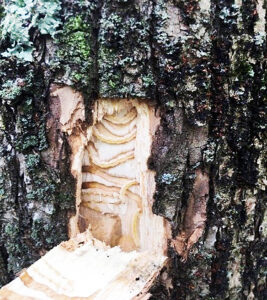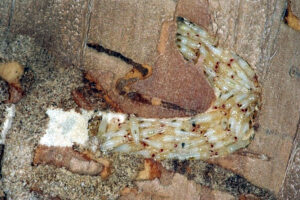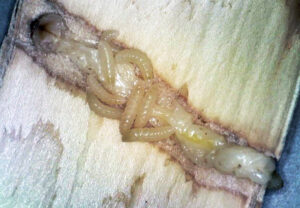By Kyle Loughlin, Field Team Lead, USDA-APHIS
kyle.m.loughlin@usda.govor 734-732-0025

USDA staff cut a ‘bark window’ in green ash to uncover signs of emerald ash borer. Photo: US Department of Agriculture
The U.S. Department of Agriculture (USDA) is asking Wisconsin landowners for help in the battle against emerald ash borer (EAB).
EAB is an invasive insect from Asia that was first introduced into the United States in 2002. Since its discovery, EAB has caused the death and decline of tens of millions of ash trees.
The USDA is asking Wisconsin landowners to donate live ash trees infested with EAB to support USDA’s biological control program. The staff will use the wood to rear EAB’s natural enemies, which will then be released in Wisconsin and 31 other EAB-infested states and Washington, D.C.

The wasp species Tetrastichus planipennisi lays its eggs inside emerald ash borer larvae where they feed and develop into red-eyed pupae before completing their lifecycle. Photo: US Department of Agriculture
USDA is interested in a minimum donation of 100 green ash trees per harvest site. USDA contractors will harvest trees weekdays between January and May at no cost to the landowner and will return the site to pre-harvest conditions, to the best of the contractor’s ability.
Biological control helps to reduce pest populations by using natural enemies such as parasitoids (stingless wasps), predators, pathogens, antagonists (to control plant diseases) or competitors. This approach is a practical option to suppress pest populations and an environmentally sound method of pest control.
The biological control staff needs more ash trees to continue producing and releasing the stingless wasps that attack and kill EAB and is asking Wisconsin residents to consider donating their ash trees this year.
“Our facility in Brighton, Michigan, is one of a kind,” said EAB biocontrol manager Ben Slager. “We rear almost a million wasps each year and provide them at no cost to our state cooperators for release. We’ve harvested EAB-infested ash in Michigan, Ohio, and last year in Wisconsin. Over the years, we have had to travel farther to find the material we need.”
Staff look for live green ash stands where trees range in size from 8 to 20 inches in diameter and show significant decline, including cracked or loose bark, dead branches and thinning leaf canopy. They also look for damage from woodpeckers feeding on EAB larva. This season, the staff will scout for potential properties in Eastern Wisconsin, ranging from Sheboygan and Fond du Lac counties to Outagamie and Door counties.
“We are making phone calls to land managers to ask for their help in locating potential sites for harvesting ash trees in the fall,” said Biocontrol Field Team Leader Kyle Loughlin. “After we get some leads on sites, we’ll visit those locations this summer to determine if they meet the criteria and develop a schedule to begin harvesting sometime in December or January.”

The stingless wasp (Spathius agrili) lays up to 20 eggs on an emerald ash borer larva. Once the eggs hatch, the wasp larvae will feed on and eventually kill the host. Photo: US Department of Agriculture
Loughlin encourages interested property owners to call him so he can answer their questions about donating their ash trees. “Many people call me because a neighbor or friend told them what we are doing,” he said. “I explain how the process works and what they can expect.
“There’s absolutely no pressure to make a decision. In fact, I recommend that they take some time to think before they move forward. Even after they decide to donate their trees, they can still change their mind.”
Contact Kyle Loughlin at 734-732-0025 or kyle.m.loughlin@usda.gov for more information.
